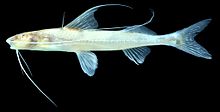| Heptapteridae | |
|---|---|
 | |
| Mastiglanis asopos | |
| Scientific classification | |
| Kingdom: | Animalia |
| Phylum: | Chordata |
| Class: | Actinopterygii |
| Order: | Siluriformes |
| Superfamily: | Pimelodoidea |
| Family: | Heptapteridae T. N. Gill, 1861[1] |
| Genera | |
| Acentronichthys | |
The Heptapteridae, or three-barbeled catfishes, are a family of catfish that originate from the Americas.[2] Most species are restricted to South America, but Imparfinis lineatus, Nemuroglanis panamensis and Pimelodella chagresi are native to Panama, and Rhamdia species occur as far north as Mexico. The name Heptapteridae is derived from Greek, hepta meaning seven and pteron meaning fin.[3]
The diversity of this family is poorly known, and many species are yet to be described.[2] So far, some 211 species have been described. This family is equivalent to the previously recognized Rhamdiinae, a subfamily of the family Pimelodidae.[2] However, molecular evidence shows this family is a part of the superfamily Pimelodoidea along with the Pimelodidae, Pseudopimelodidae, and Conorhynchos.[4]
The skin of these fish is usually naked (scaleless). They exhibit three pairs of barbels. They have a large adipose fin, and their caudal fin is deeply forked. However, no external characteristics unique to this family allow it to be differentiated from the Pimelodidae.[2]
The Heptapteridae include a few troglobitic species in the genera Pimelodella, Rhamdia, Rhamdiopsis, and Taunayia.[5][6]
References
- ^ "Heptapteridae". Integrated Taxonomic Information System. Retrieved 7 April 2007.
- ^ a b c d Nelson, Joseph, S. (2006). Fishes of the World. John Wiley & Sons, Inc. ISBN 0-471-25031-7.
- ^ Froese, Rainer, and Daniel Pauly, eds. (2007). "Heptapteridae" in FishBase. Apr 2007 version.
- ^ Sullivan, JP; Lundberg JG; Hardman M (2006). "A phylogenetic analysis of the major groups of catfishes (Teleostei: Siluriformes) using rag1 and rag2 nuclear gene sequences". Mol Phylogenet Evol. 41 (3): 636–62. doi:10.1016/j.ympev.2006.05.044. PMID 16876440.
- ^ Bichuette, Maria Elina; Trajano, Eleonora (2005). "A new cave species of Rhamdia (Siluriformes: Heptapteridae) from Serra do Ramalho, northeastern Brazil, with notes on ecology and behavior". Neotropical Ichthyology. 3 (4): 587–595. doi:10.1590/S1679-62252005000400016.
- ^ Bockmann; and Castro (2010). The blind catfish from the caves of Chapada Diamantina, Bahia, Brazil (Siluriformes: Heptapteridae): description, anatomy, phylogenetic relationships, natural history, and biogeography. Neotrop. Ichthyol. 8(4). doi:10.1590/S1679-62252010000400001